Investigation of a Compound Parabolic Collector with a Flat Glazing
Abstract
1. Introduction
2. Material and Methods
2.1. The Designed CPC with Flat Glazing
2.2. Basic Mathematical Formulation Part
2.3. Details of the Simulation Process
- (A)
- The solar irradiation on the collector aperture is selected at 800 W/m2.
- (B)
- The solar angle is equal to zero, and thus, the solar rays are vertical to the collector opening.
- (C)
- The inlet temperature in the system is chosen to vary from 10 °C up to 110 °C.
- (D)
- The ambient temperature was selected at 10 °C.
- (E)
- The heat convection coefficient with the environment was chosen at 10 W/m2K [32].
- (F)
- The mass flow rate of the pressurized water was selected at 0.01 kg/s in the inlet.
- (G)
- The outlet pressure was chosen at 5 bar.
3. Results and Discussion
3.1. Thermal and Exergy Performance Analysis
3.2. Peripheral Analysis on the Absorber Tube
3.3. Temperature Distribution Profiles
4. Conclusions
- -
- The cover and receiver temperatures as well as the thermal losses have linear increasing rates with the rise of the pressurized water’s temperature at the inlet.
- -
- The mean heat convection value was calculated close to 3.8 W/m2K, which is a reasonable value for a closed cavity.
- -
- The CPC collector with flat glazing is an efficient design that presents thermal efficiency in the range of 32.6% up to 77.4% when the pressurized water temperature operates in the range of 110 °C down to 10 °C.
- -
- The exergy efficiency of the unit presents maximum performance for an inlet temperature of 90 °C at 10.19%. This result shows the solar unit is suitable for applications, such as solar cooling and desalination.
- -
- There is a need to add extra insulation in the corners of the external surface to properly face the geometrical thermal bridges at the angles, which improves the overall collector performance.
Author Contributions
Funding
Institutional Review Board Statement
Informed Consent Statement
Data Availability Statement
Acknowledgments
Conflicts of Interest
Nomenclature
| Aa | Area of the cover, m2 |
| cp | Specific heat capacity, J/kgK |
| Dri | Inner diameter of the receiver tube, m |
| Dro | Outer diameter of the receiver tube, m |
| G | Solar irradiation, W/m2 |
| hair | Heat convection between the absorber and inside air, W/m2K |
| hca | Convective coefficient between cover and ambient, W/m2K |
| L | Collector length, m |
| m | Mass flow rate, kg/s |
| Tam | Ambient temperature, °C |
| Tc | Cover temperature, °C |
| Tin | Inlet temperature, °C |
| Tout | Outlet temperature, °C |
| Tr | Absorber temperature, °C |
| Tsun | Sun temperature, K |
| Qabs | Absorbed energy rate, W |
| Qloss | Thermal losses rate, W |
| Qu | Useful energy rate, W |
| Ut | Top thermal loss coefficient, W/m2K |
| W | Collector width, m |
| Greek Symbols | |
| β | Absorber angle, ° |
| θ | Solar angle at the cover surface, ° |
| ηex | Exergy efficiency |
| ηth | Thermal efficiency |
| ηopt | Optical efficiency |
| Subscripts and Superscripts | |
| loss, edge | Losses from the edge of the collector |
| loss, total | Losses of the total collector |
| loss, top | Losses of the top part of the collector |
| Abbreviations | |
| CPC | Compound parabolic concentrator |
References
- Tian, M.; Su, Y.; Zheng, H.; Pei, G.; Li, G.; Riffat, S. A review on the recent research progress in the compound parabolic concentrator (CPC) for solar energy applications. Renew. Sustain. Energy Rev. 2018, 82, 1272–1296. [Google Scholar] [CrossRef]
- Yuan, G.; Fan, J.; Kong, W.; Furbo, S.; Perers, B.; Sallaberry, F. Experimental and computational fluid dynamics investigations of tracking CPC solar collectors. Sol. Energy 2020, 199, 26–38. [Google Scholar] [CrossRef]
- Masood, F.; Nor, N.B.M.; Nallagownden, P.; Elamvazuthi, I.; Saidur, R.; Alam, M.A.; Akhter, J.; Yusuf, M.; Mehmood, M.; Ali, M. A Review of Recent Developments and Applications of Compound Parabolic Concentrator-Based Hybrid Solar Photovoltaic/Thermal Collectors. Sustainability 2022, 14, 5529. [Google Scholar] [CrossRef]
- Winston, R. Principles of solar concentrators of a novel design. Sol. Energy 1974, 16, 89–95. [Google Scholar] [CrossRef]
- Xu, Z.; Wang, R. Comparison of CPC driven solar absorption cooling systems with single, double and variable effect absorption chillers. Sol. Energy 2017, 158, 511–519. [Google Scholar] [CrossRef]
- Sharma, G.K.; Kumar, N.; Singh, D.B.; Mallick, A. Exergoeconoic analysis of single slope solar desalination unit coupled with PVT-CPCs by incorporating the effect of dissimilarity of the rate of flowing fluid mass. Mater. Today Proc. 2020, 28, 2364–2368. [Google Scholar] [CrossRef]
- Carlini, M.; Rotondo, M.; Marcantonio, V.; Pierini, D.; Mennuni, A. Modeling and simulation of a cooled CPC-ORC coupled system: Performance analysis. Energy Rep. 2022, 8, 908–923. [Google Scholar] [CrossRef]
- Kurhe, N.; Pathak, A.; Deshpande, K.; Jadkar, S. Compound parabolic solar collector—Performance evaluation as per standard test method and actual field conditions for industrial process heat application in Indian context. Energy Sustain. Dev. 2020, 57, 98–108. [Google Scholar] [CrossRef]
- Said, Z.; Ghodbane, M.; Boumeddane, B.; Tiwari, A.K.; Sundar, L.S.; Li, C.; Aslfattahi, N.; Bellos, E. Energy, exergy, economic and environmental (4E) analysis of a parabolic trough solar collector using MXene based silicone oil nanofluids. Sol. Energy Mater. Sol. Cells 2022, 239, 111633. [Google Scholar] [CrossRef]
- Bellos, E. Progress in the design and the applications of linear Fresnel reflectors—A critical review. Therm. Sci. Eng. Prog. 2019, 10, 112–137. [Google Scholar] [CrossRef]
- Garg, A.; Ray, B.; Jain, S. Development of Nusselt number correlation for solar CPC with a tubular receiver. Therm. Sci. Eng. Prog. 2023, 37, 101553. [Google Scholar] [CrossRef]
- Qiu, Y.; Li, M.-J.; Wang, K.; Liu, Z.-B.; Xue, X.-D. Aiming strategy optimization for uniform flux distribution in the receiver of a linear Fresnel solar reflector using a multi-objective genetic algorithm. Appl. Energy 2017, 205, 1394–1407. [Google Scholar] [CrossRef]
- Subramaniyan, C.; Subramani, J.; Kalidasan, B.; Anbuselvan, N.; Yuvaraj, T.; Prabaharan, N.; Senjyu, T. Investigation on the Optical Design and Performance of a Single-Axis-Tracking Solar Parabolic trough Collector with a Secondary Reflector. Sustainability 2021, 13, 9918. [Google Scholar] [CrossRef]
- Devanarayanan, K.; Murugavel, K.K. Integrated collector storage solar water heater with compound parabolic concentrator—Development and progress. Renew. Sustain. Energy Rev. 2014, 39, 51–64. [Google Scholar] [CrossRef]
- Ma, G.; Yin, Z.; Liu, X.; Qi, J.; Dai, Y. Developments of CPC solar evacuated glass tube collector with a novel selective coating. Sol. Energy 2021, 220, 1120–1129. [Google Scholar] [CrossRef]
- Liu, Z.; Tao, G.; Lu, L.; Wang, Q. A novel all-glass evacuated tubular solar steam generator with simplified CPC. Energy Convers. Manag. 2014, 86, 175–185. [Google Scholar] [CrossRef]
- Korres, D.; Tzivanidis, C. A new mini-CPC with a U-type evacuated tube under thermal and optical investigation. Renew. Energy 2018, 128, 529–540. [Google Scholar] [CrossRef]
- Bellos, E.; Korres, D.; Tzivanidis, C.; Antonopoulos, K. Design, simulation and optimization of a compound parabolic collector. Sustain. Energy Technol. Assess. 2016, 16, 53–63. [Google Scholar] [CrossRef]
- Korres, D.; Bellos, E.; Tzivanidis, C. Investigation of a nanofluid-based compound parabolic trough solar collector under laminar flow conditions. Appl. Therm. Eng. 2019, 149, 366–376. [Google Scholar] [CrossRef]
- Souliotis, M.; Tripanagnostopoulos, Y. Experimental study of CPC type ICS solar systems. Sol. Energy 2004, 76, 389–408. [Google Scholar] [CrossRef]
- Tripanagnostopoulos, Y.; Souliotis, M. ICS solar systems with two water tanks. Renew. Energy 2006, 31, 1698–1717. [Google Scholar] [CrossRef]
- Tripanagnostopoulos, Y.; Souliotis, M. ICS solar systems with horizontal (E–W) and vertical (N–S) cylindrical water storage tank. Renew. Energy 2004, 29, 73–96. [Google Scholar] [CrossRef]
- Tripanagnostopoulos, Y.; Souliotis, M. Integrated collector storage solar systems with asymmetric CPC reflectors. Renew. Energy 2004, 29, 223–248. [Google Scholar] [CrossRef]
- Korres, D.N.; Bellos, E.; Tzivanidis, C. Integration of a Linear Cavity Receiver in an Asymmetric Compound Parabolic Collector. Energies 2022, 15, 8635. [Google Scholar] [CrossRef]
- Zhang, X.; Jiang, S.; Lin, Z.; Gui, Q.; Chen, F. Model construction and performance analysis for asymmetric compound parabolic concentrator with circular absorber. Energy 2023, 267, 126597. [Google Scholar] [CrossRef]
- Redpath, D.; Paneri, A.; Singh, H.; Ghitas, A.; Sabry, M. Design of a Building-Scale Space Solar Cooling System Using TRNSYS. Sustainability 2022, 14, 11549. [Google Scholar] [CrossRef]
- Garcia, J.M.; Rosa, A. Theoretical Study of an Intermittent Water-Ammonia Absorption Solar System for Small Power Ice Production. Sustainability 2019, 11, 3346. [Google Scholar] [CrossRef]
- Masood, F.; Nallagownden, P.; Elamvazuthi, I.; Akhter, J.; Alam, M. A New Approach for Design Optimization and Parametric Analysis of Symmetric Compound Parabolic Concentrator for Photovoltaic Applications. Sustainability 2021, 13, 4606. [Google Scholar] [CrossRef]
- SOLIDWORKS Flow Simulation. SOLIDWORKS 2017. Available online: https://www.solidworks.com/product/solidworks-flow-simulation (accessed on 24 January 2023).
- Petela, R. Exergy of undiluted thermal radiation. Sol. Energy 2003, 74, 469–488. [Google Scholar] [CrossRef]
- Vahidinia, F.; Khorasanizadeh, H.; Aghaei, A. Energy, exergy, economic and environmental evaluations of a finned absorber tube parabolic trough collector utilizing hybrid and mono nanofluids and comparison. Renew. Energy 2023, 205, 185–199. [Google Scholar] [CrossRef]
- Qiu, Y.; Li, M.-J.; He, Y.-L.; Tao, W.-Q. Thermal performance analysis of a parabolic trough solar collector using supercritical CO2 as heat transfer fluid under non-uniform solar flux. Appl. Therm. Eng. 2017, 115, 1255–1265. [Google Scholar] [CrossRef]
- Zhang, F.; Yin, Y.; Cao, B.; Wang, Y. Performance analysis of a novel dual-evaporation-temperature combined-effect absorption chiller for temperature and humidity independent control air-conditioning. Energy Convers. Manag. 2022, 273, 116417. [Google Scholar] [CrossRef]
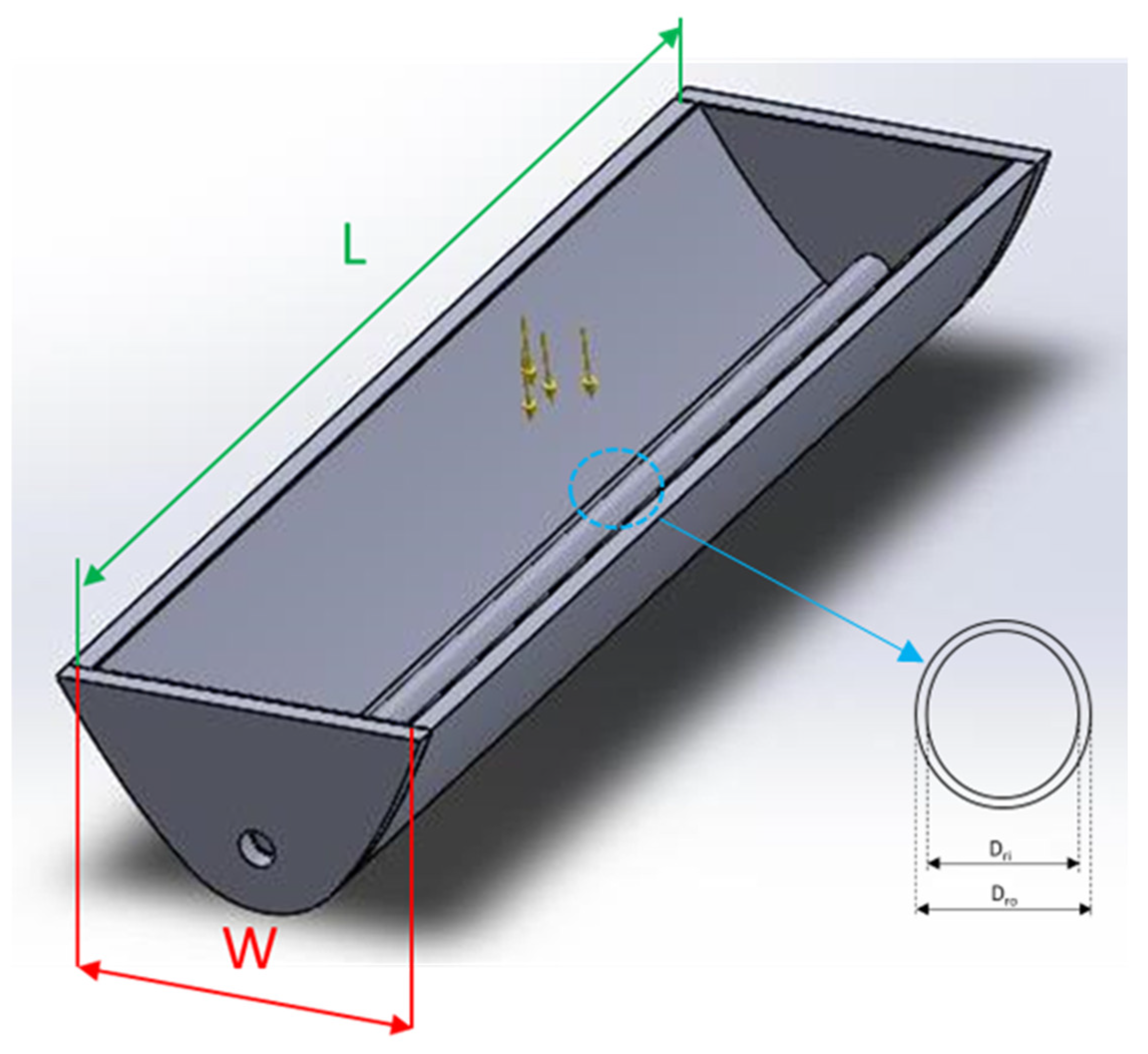
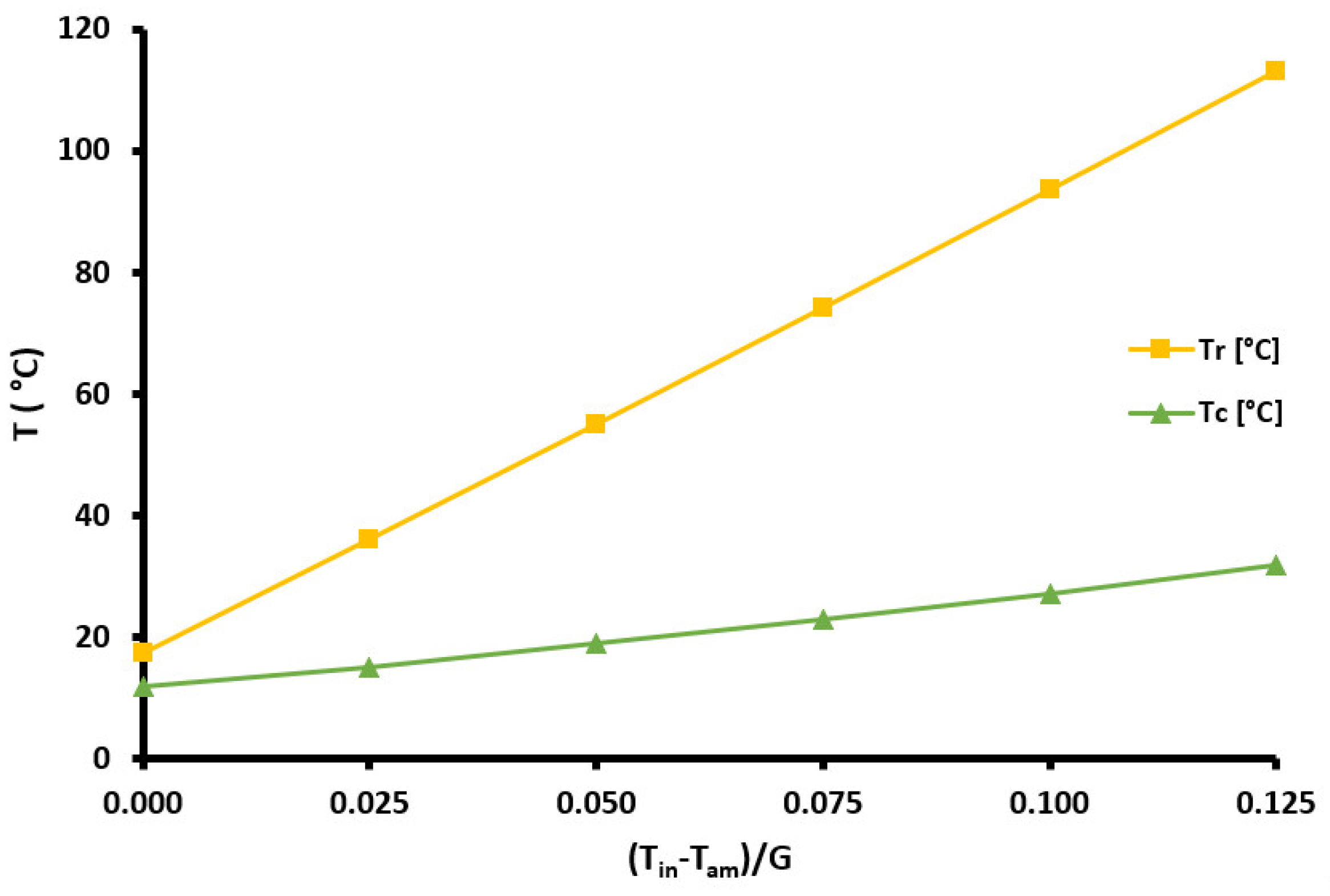
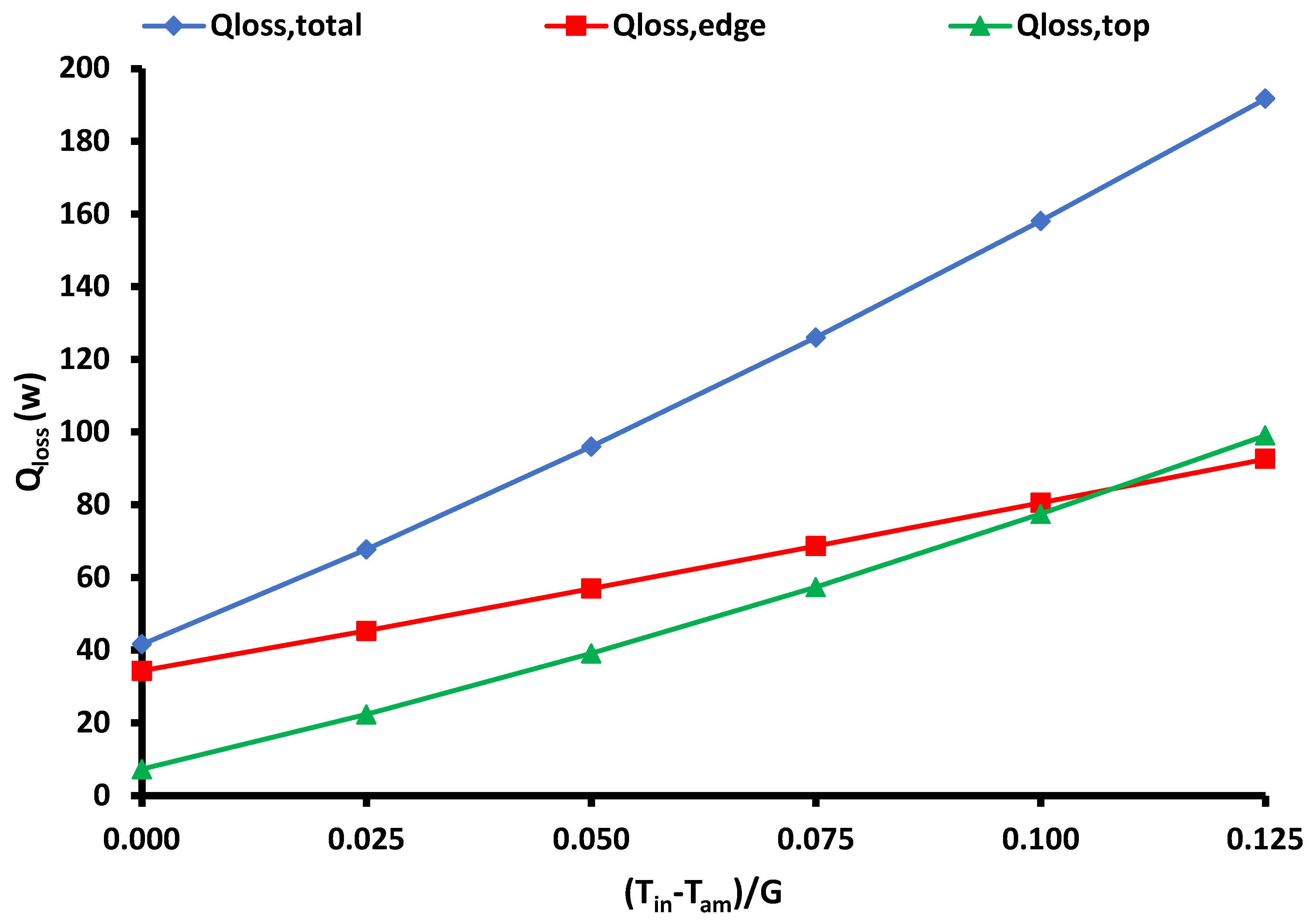

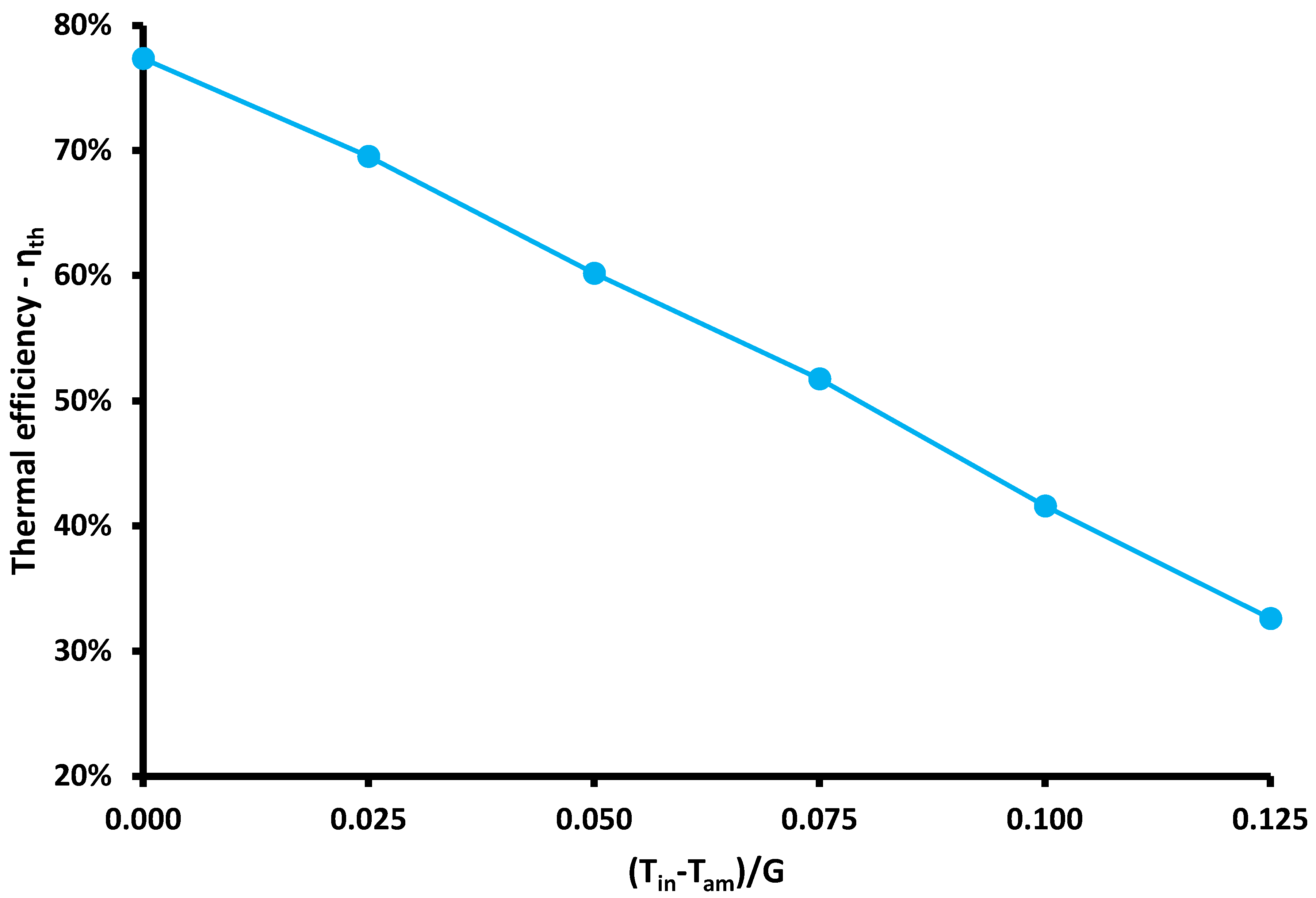
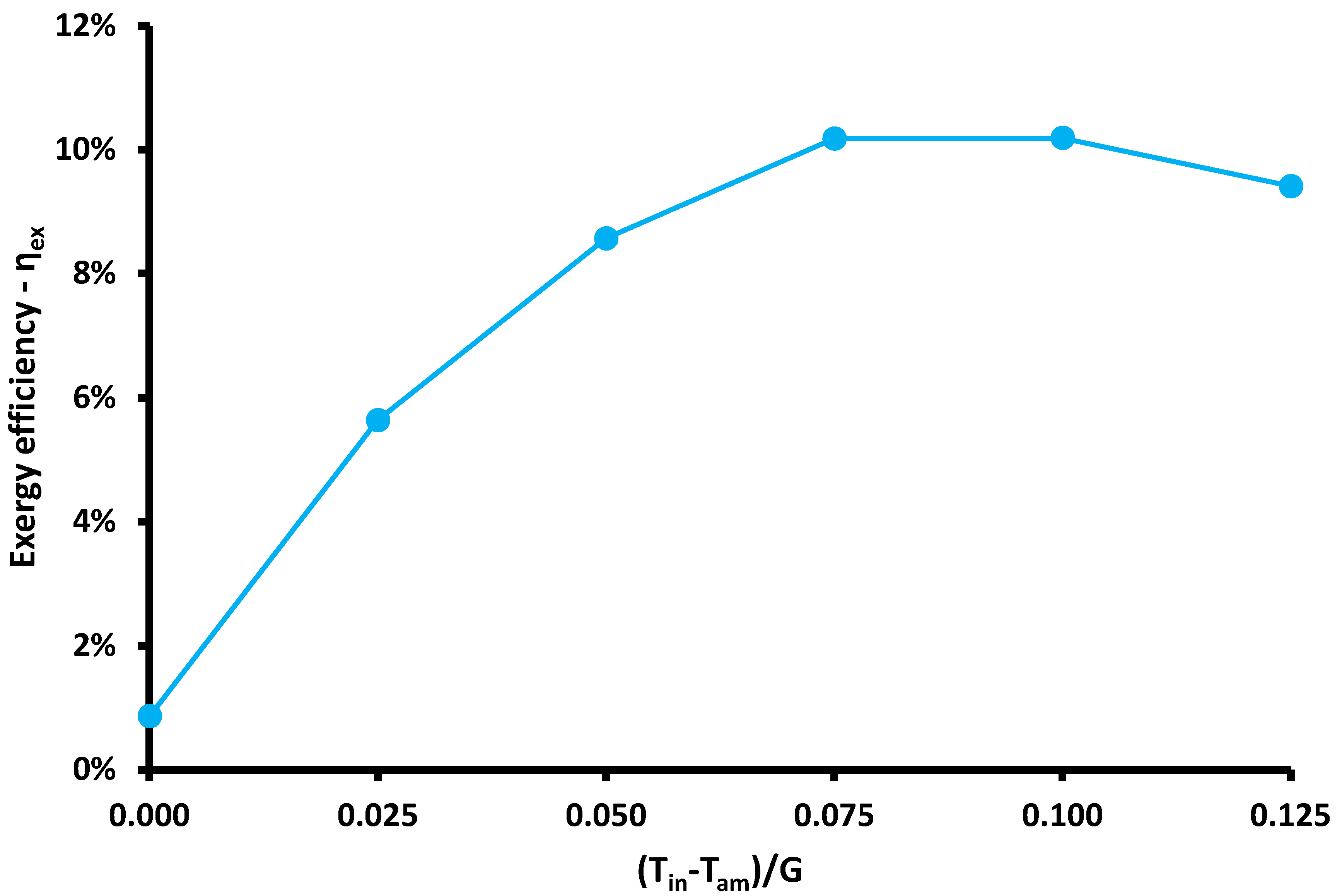
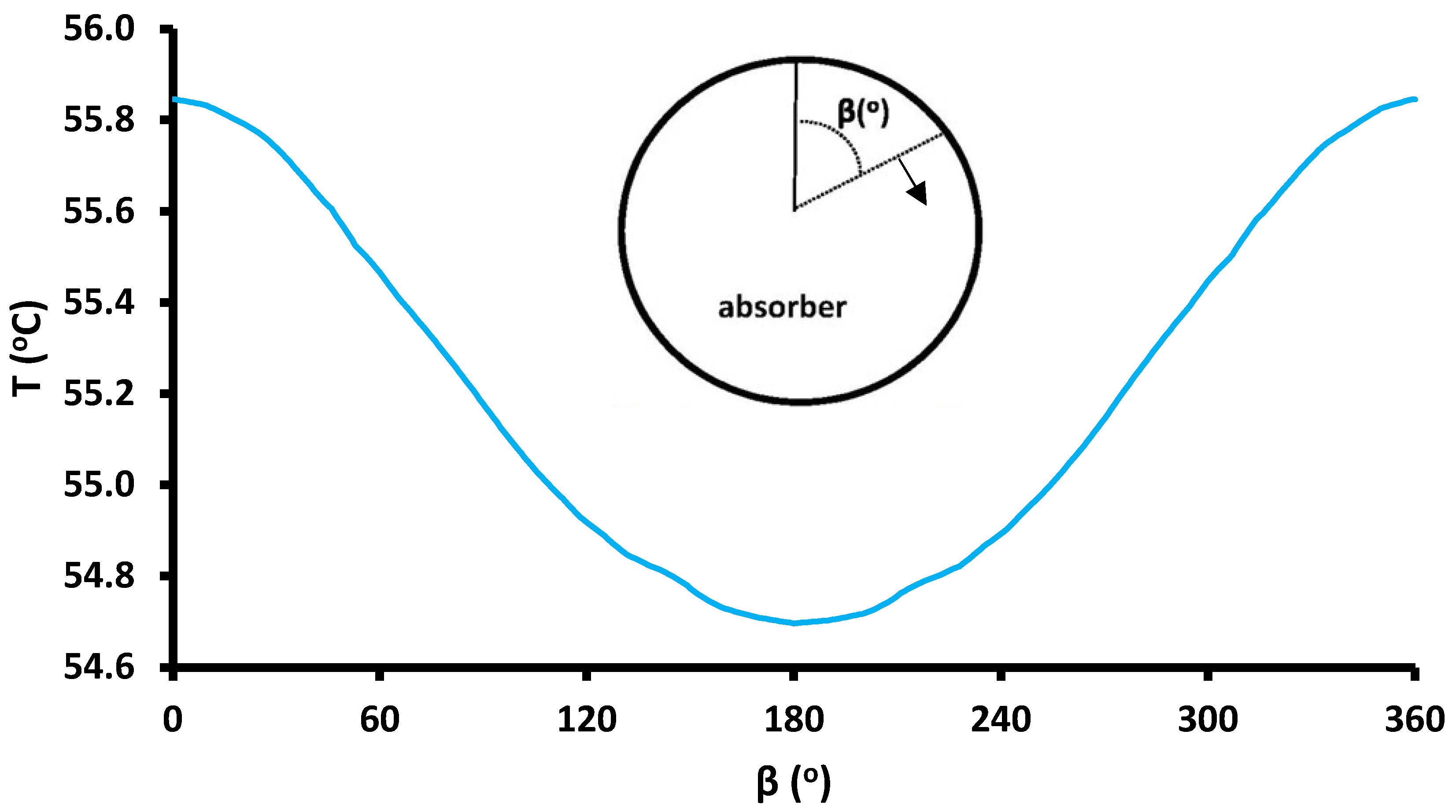
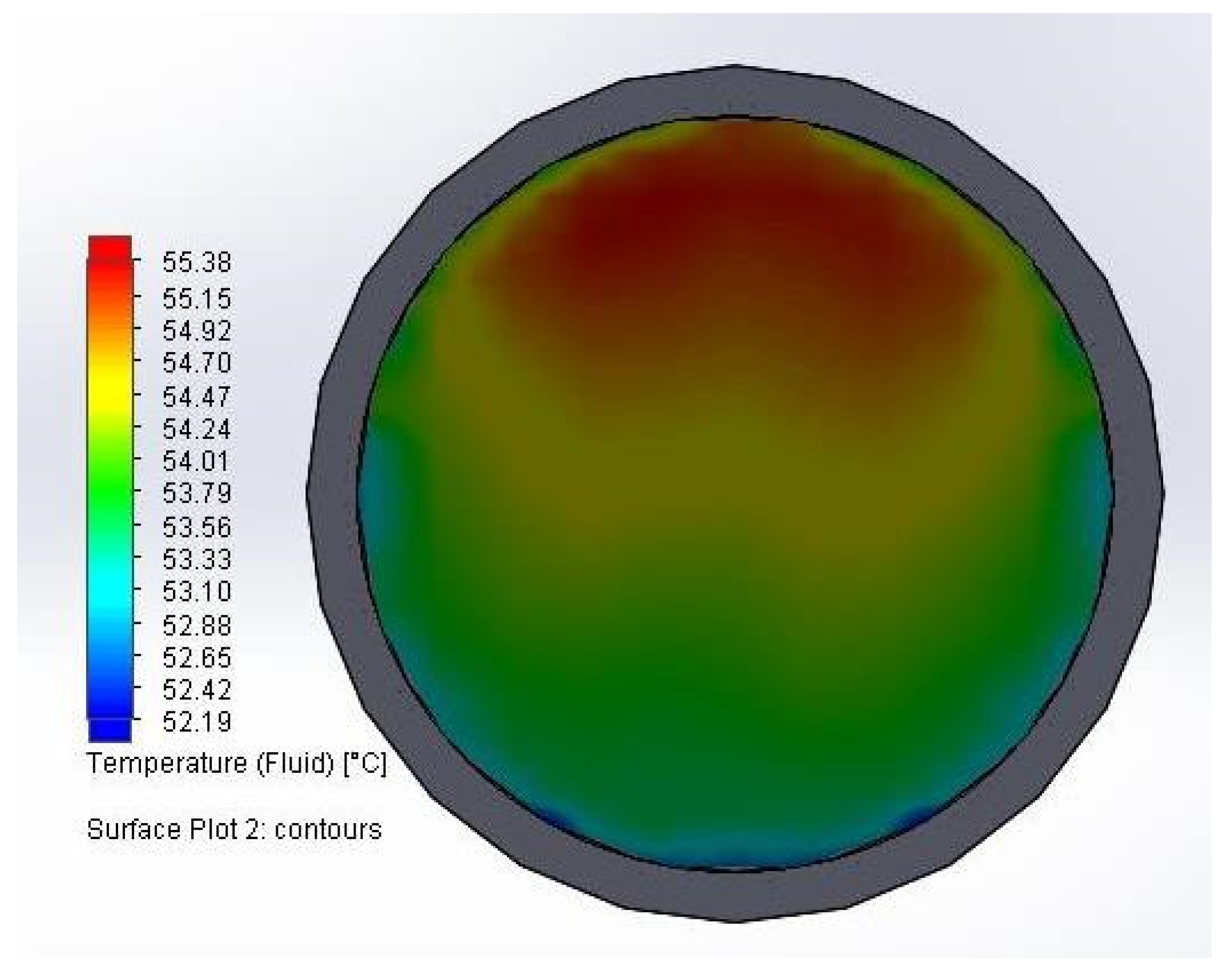
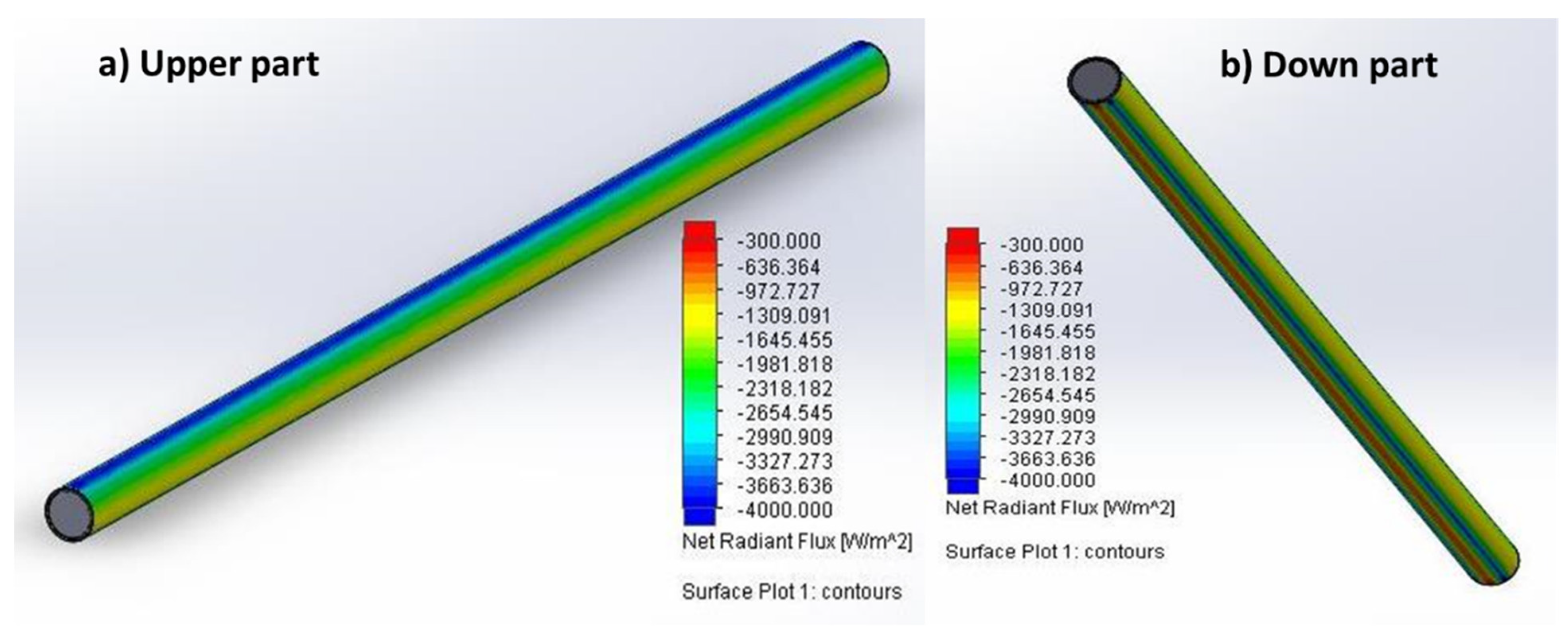
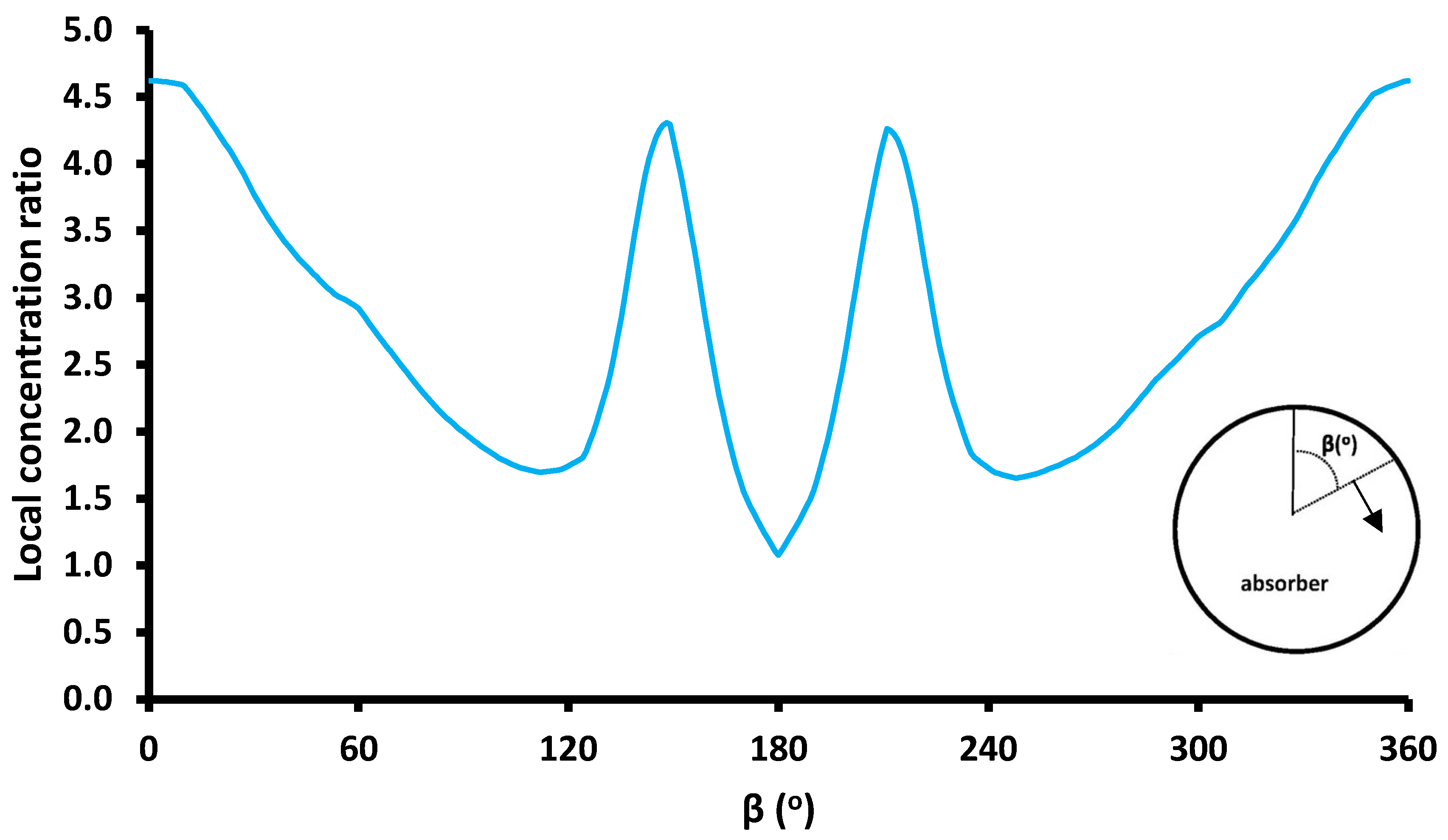
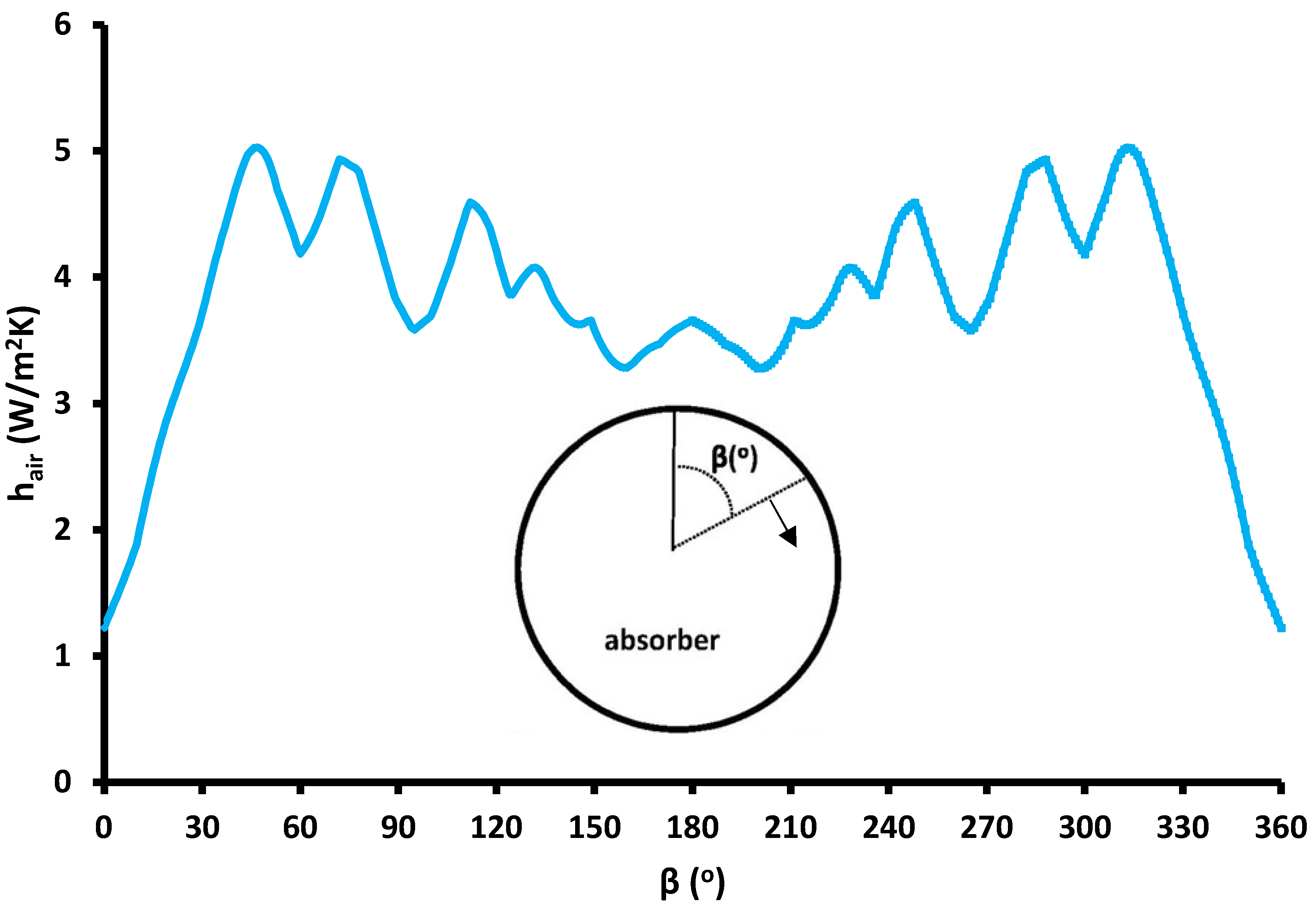
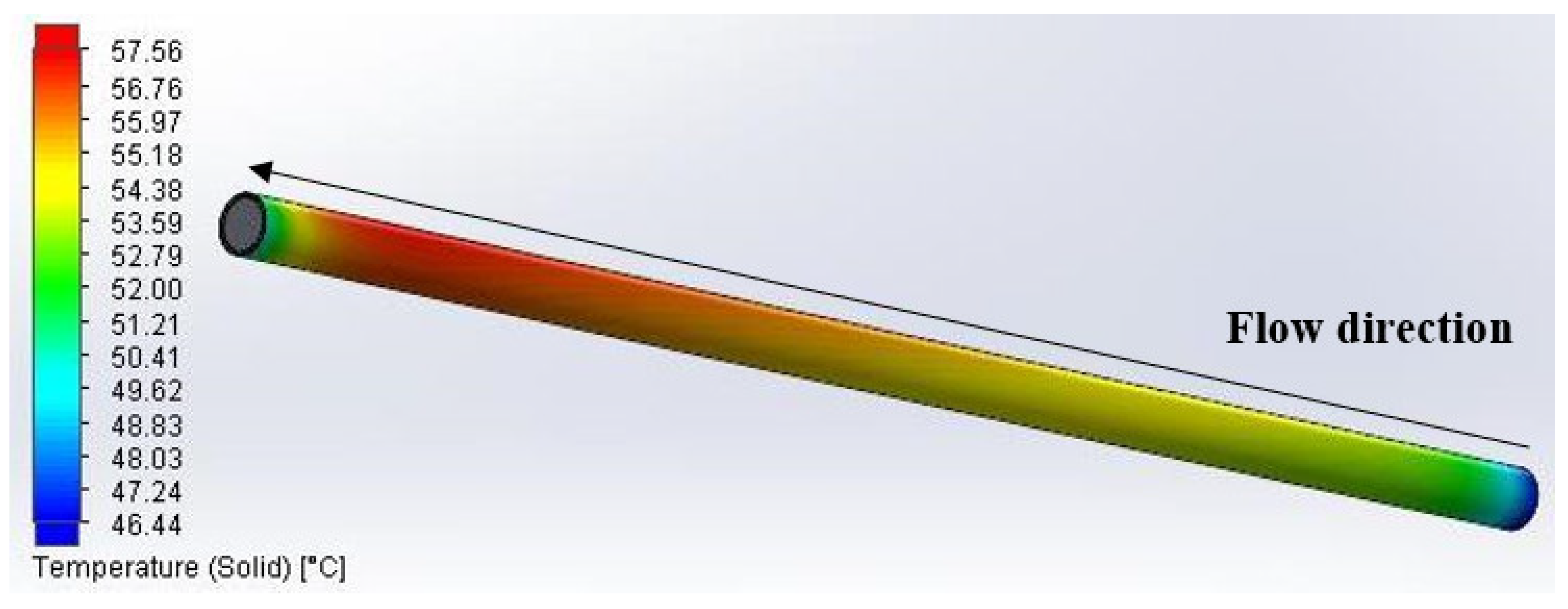

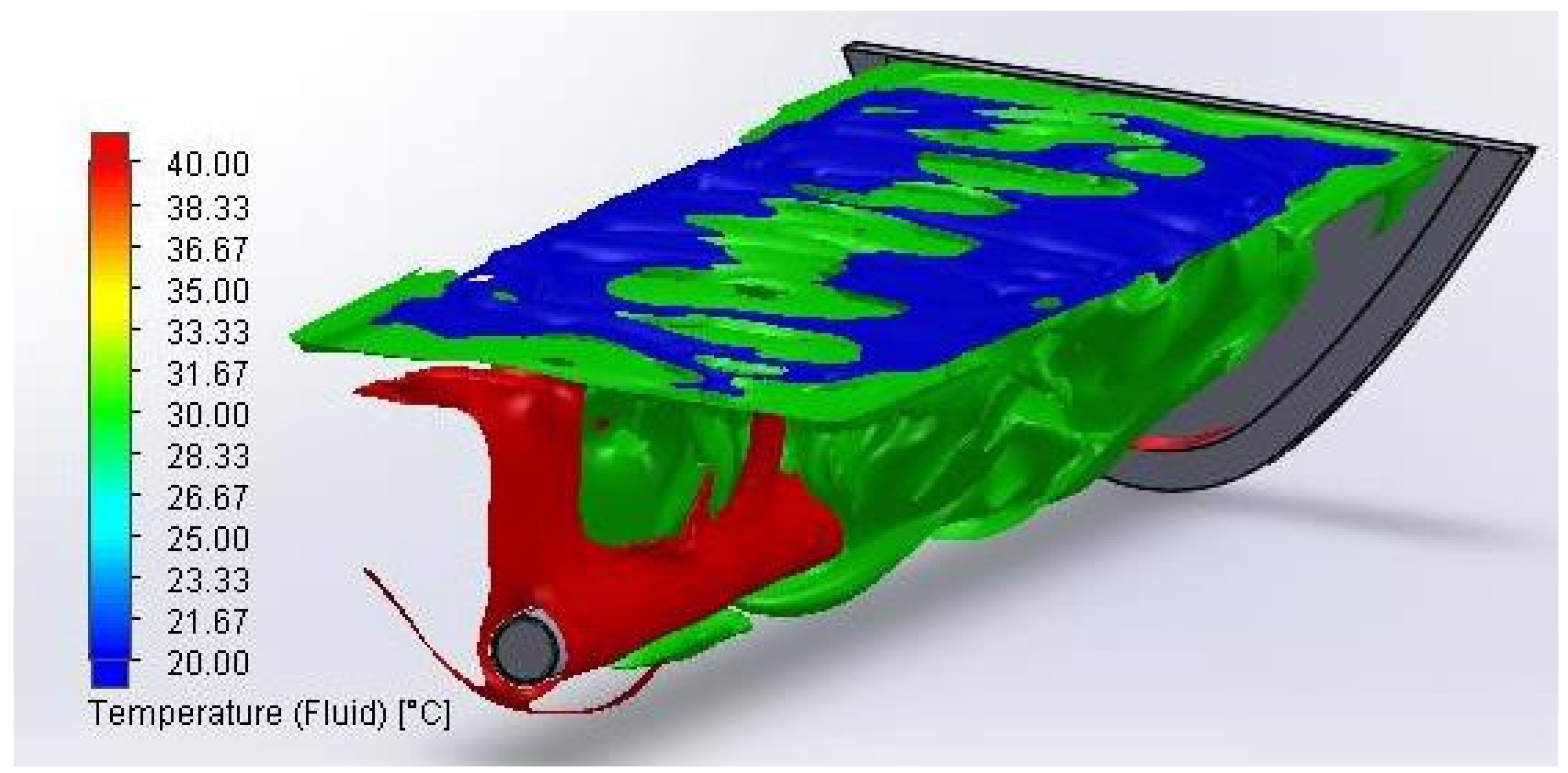
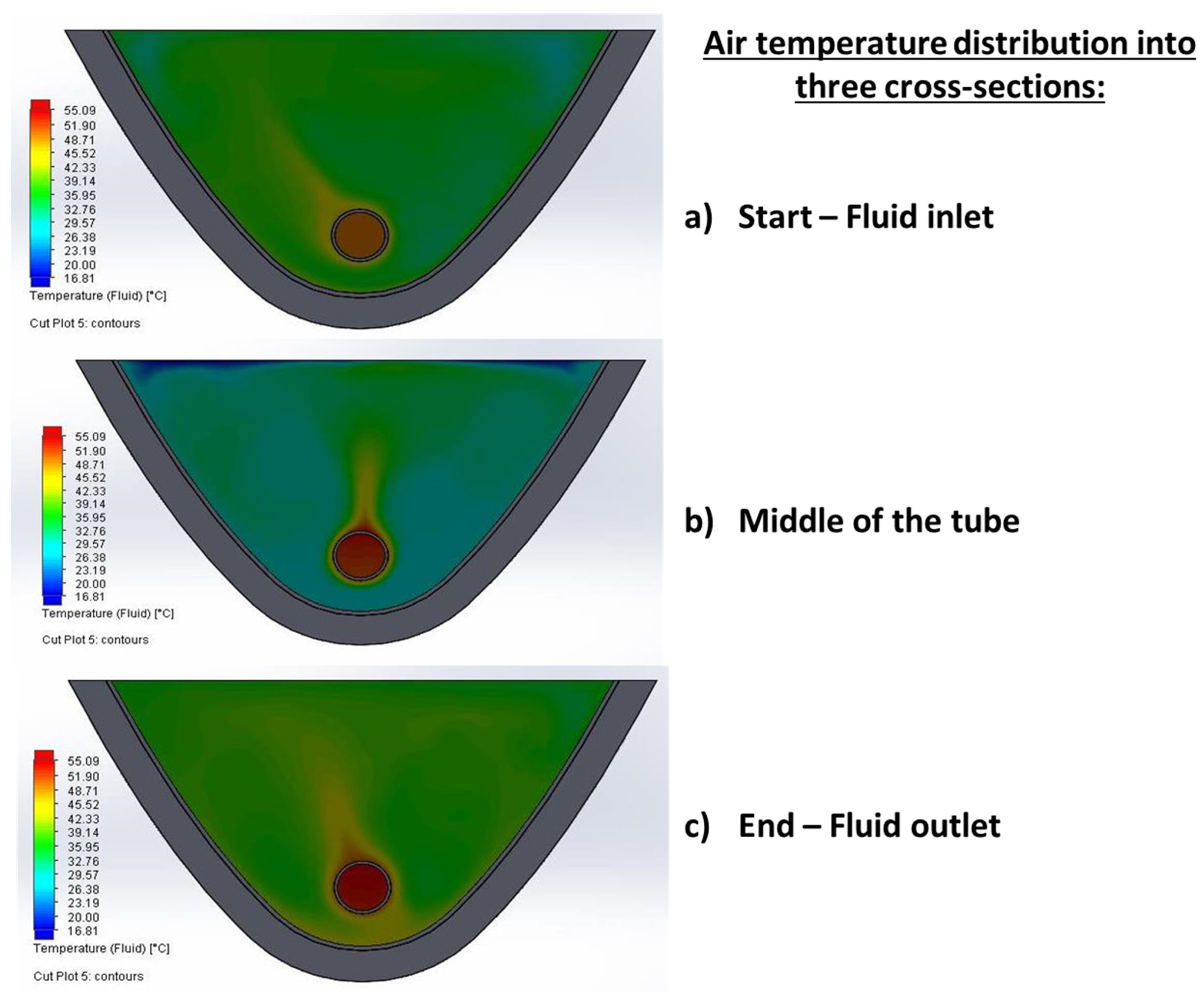
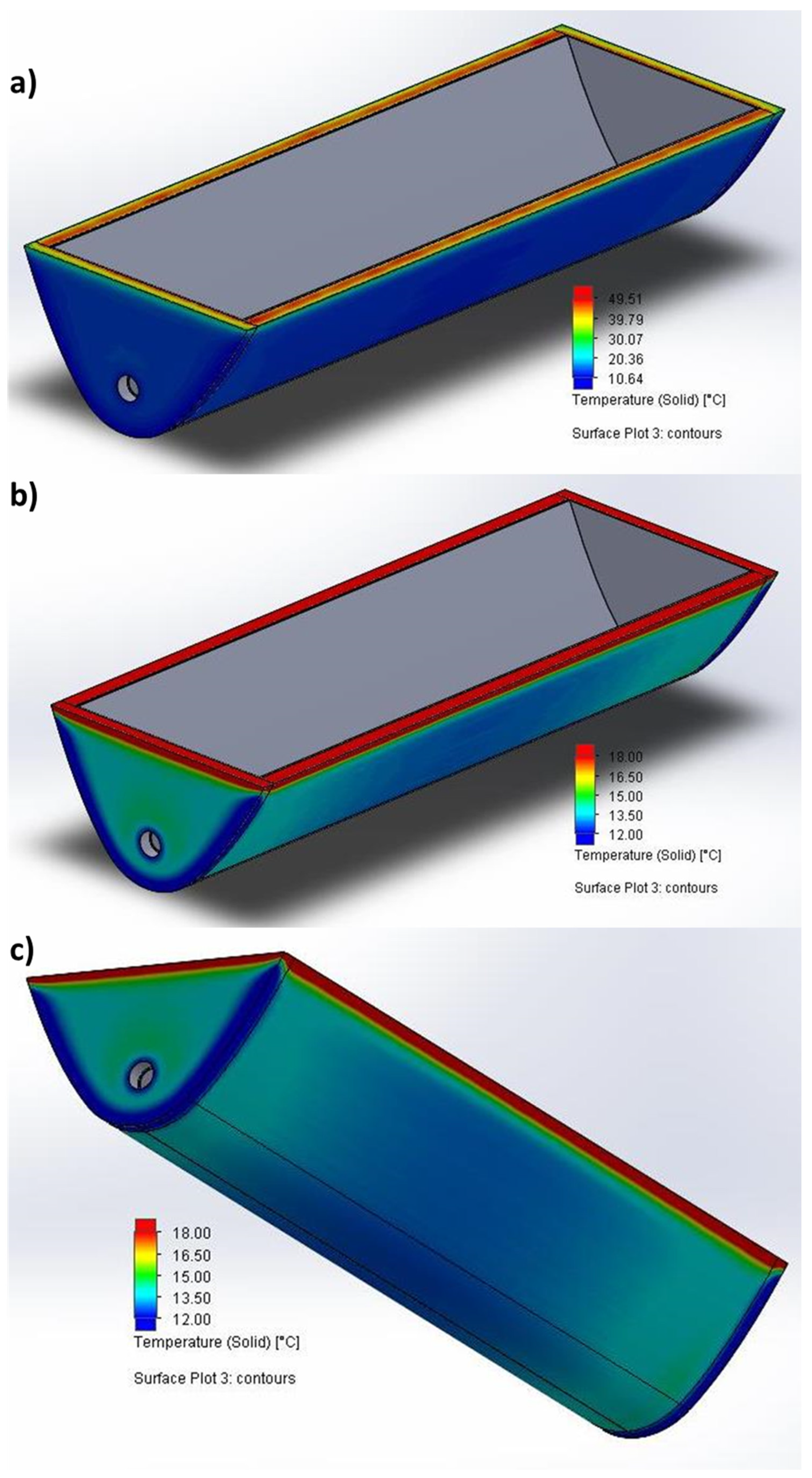
| Parameters | Values |
|---|---|
| Concentration ratio | 2.81 |
| Absorber emissivity | 0.1 |
| Glass cover emissivity | 0.88 |
| Optical efficiency for zero solar angle | 80% |
| Useful collector’s width | 0.3 m |
| Useful collector’s length | 1 m |
| Focal distance of the parabola | 0.05 m |
| Absorber inside diameter | 0.030 m |
| Absorber outside diameter | 0.034 m |
| Cover thickness | 4 mm |
| External insulation thickness | 0.02 m |
| Thermal conductivity of the insulation | 0.035 W/mK |
| Parameter | Symbol | Values |
|---|---|---|
| Mass flow rate | m | 0.01 kg/s |
| Inlet temperature | Tin | 10, 30, 50, 70, 90, 110 °C |
| Ambient temperature | Tam | 10 °C |
| Heat convection coefficient with the ambient | hca | 10 W/m2K |
| Solar irradiation | G | 800 W/m2 |
| Solar angle | θ | 0° |
Disclaimer/Publisher’s Note: The statements, opinions and data contained in all publications are solely those of the individual author(s) and contributor(s) and not of MDPI and/or the editor(s). MDPI and/or the editor(s) disclaim responsibility for any injury to people or property resulting from any ideas, methods, instructions or products referred to in the content. |
© 2023 by the authors. Licensee MDPI, Basel, Switzerland. This article is an open access article distributed under the terms and conditions of the Creative Commons Attribution (CC BY) license (https://creativecommons.org/licenses/by/4.0/).
Share and Cite
Bellos, E.; Korres, D.N.; Tzivanidis, C. Investigation of a Compound Parabolic Collector with a Flat Glazing. Sustainability 2023, 15, 4347. https://doi.org/10.3390/su15054347
Bellos E, Korres DN, Tzivanidis C. Investigation of a Compound Parabolic Collector with a Flat Glazing. Sustainability. 2023; 15(5):4347. https://doi.org/10.3390/su15054347
Chicago/Turabian StyleBellos, Evangelos, Dimitrios N. Korres, and Christos Tzivanidis. 2023. "Investigation of a Compound Parabolic Collector with a Flat Glazing" Sustainability 15, no. 5: 4347. https://doi.org/10.3390/su15054347
APA StyleBellos, E., Korres, D. N., & Tzivanidis, C. (2023). Investigation of a Compound Parabolic Collector with a Flat Glazing. Sustainability, 15(5), 4347. https://doi.org/10.3390/su15054347








